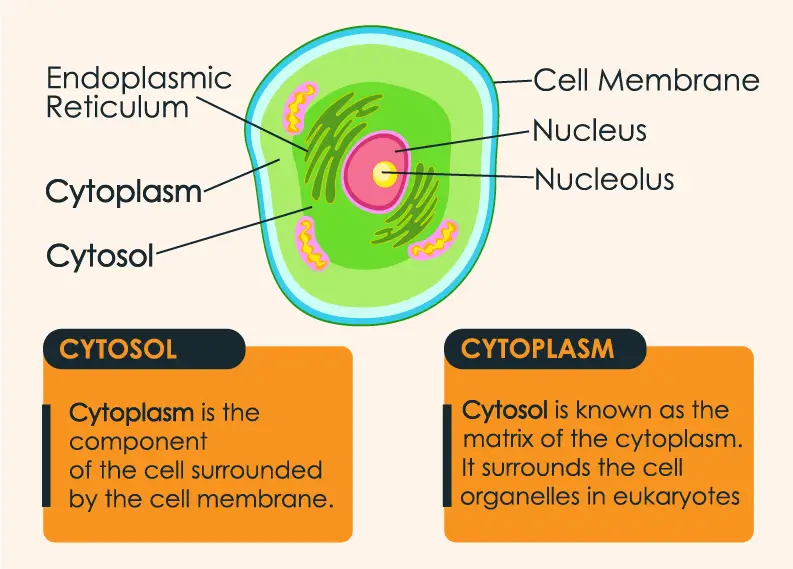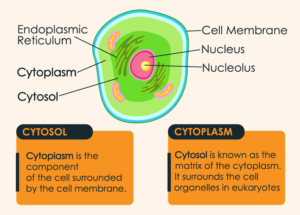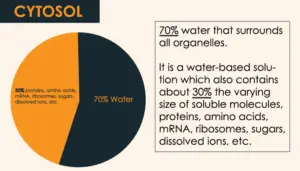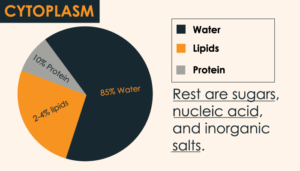
Cytosol vs Cytoplasm Definition, Difference, and Comparison
Both are in actual distinct things, as the majority think both are two different names of the same thing. It is the fluid present inside the covering known as cytoplasm. Both possess a very crucial part in the cell which is a very fundamental unit of all life kinds.
Before we break down into detail, let’s have an introduction to some basic things that will surely assist You get better insights of these two terms.
also read: Difference between hemoglobin vs myosin
What is a cell
A cell is a very basic unit of every organism. In simple words, a cell is a building block that together with other similar cells makes a whole organism.
Cells join to make tissues and tissues join to make an organ, while organs together make a whole framework that is employed in an organism.
A cell is an extremely small entity that even not possible to experience with naked eyes, but it possesses a very complicated framework employed by nature and massive information about the organism in the form of a genome or DNA.
Cytoplasm vs Cytosol Differences`One By One:
| CYTOPLASM | CYTOSOL |
| It exists within the nuclear envelope and cellular membrane. | It is present within the nuclear envelope and cytoplasm. |
| Its composition is divided into carbohydrates, lipids, proteins, inorganic ions, and nucleic acid. | Its composition arises from water, soluble proteins, and ions. |
| It is considered in large cell activities, for instance, mitosis, meiosis, and glycolysis. | All the chemical reactions in prokaryotes take place within the cytosolic space. |
| The surface area it covers in the cell body is higher. | The surface area that it covers in the cellular body is lower than the cytoplasm. |
| It is the region where nuclear partition and cytokinesis (a division of the cytoplasm) happens | It is the region where phenomena like signal transduction and molecule transport happen. |
| It possesses physical nature like gelatin and has semi-transparent fluidity. | It is an intracellular fluid present within the cell after the cytoplasm. |
| It encases almost entire organelles for instance; vacuoles, plastids, nucleus & nucleolus, mitochondria, and rough ER smooth ER. | Cytosol key components include protein compartment, cytoskeletal sieving, and concentration gradient. |
Video explaining cytosol and cytoplasm difference:

Both are completely distinct but very crucial and relatable cellular entities. The cytosol is the intra-cellular viscous component that exists within the cell. It is the cytoplasm’s part that is not supported by any other cell organelle. It is the fluid part isolated from cell organelles that glide about in the its region.
While the cytoplasm is the cell part entirely enveloped in the cell membrane. It is the whole substance cell membrane embedded other than the core cell entities. The whole organelles of the cell are bounded in the cytoplasm. The focal granular mass in it is known as endoplasm, on the other hand, the encompassing translucent layer is known as the ectoplasm.
It is the region where entire metabolic chemical reactions of prokaryotic cells happen. On conversely the huge scope cell occurrences including cell division, glycolysis, and other paths related to metabolism goes on in the cytoplasm. The cytoplasm is like gelatine hazy fluid that works like the cell’s filling. It possesses vacuoles, plastids, ER, cell wall, mitochondria, and Golgi apparatus.
The significant ingredients in the cytosolic space are proteins, cytoskeletal sieving, and concentration gradient. Despite the fact that none of these parts are estranged by cell membrane still they don’t blend as various degrees of association limit positive particles to unmistakable districts inside the cytosolic region. While cytoplasm is made of three key components including cellular organelles, inclusions, and cytosol.
The indispensable cytosolic synthesis contains a great deal of water, broken down particles, enormous water-soluble atoms, and minute protein particles. The mix of minute particles is an unreasonably convoluted arrangement including every single atom needed metabolism. While Cytoplasm is composed of water up to 80%. Different substances exist in the cytoplasm are nucleic acids, lipids, proteins, amino acids, starches, inorganic ions, and lightweight sub-atomic compounds.
Cytoplasm additionally contains nutrients & salts in a disintegrated state which assists with getting the water segments effectively consumed/absorbed by the cell. It is a brilliant electricity conductor. Additionally, its existence inside the cell encourages different cell entities to wander all-around inside the cell with the cytoplasmic streaming assistance.
What is the cytosol ?
The cell’s cytoplasmic aqueous chamber that is employed to hold certain cellular organelles or act as a home for all of them.
Definition of cytosol
It is the outbound matrix that surrounds the entire eukaryotic cellular organelles residing in the cytoplasm. In the case of eukaryotic cytosol, the entire metabolic activities are going on here.
Composition of Cytosol

The cytosol is primarily composed of dissolved ions and tiny & large water-soluble molecules. It disintegrates molecules that are non-protein in nature and are tinier in size as less than 300 Daltons. The cytoplasm in plant cells has the capability to dissolve around 200,000 various molecules. Water compose-up around 70% of the entire cellular volume. Consequently, its PH ranges from 7.0 to 7.4
The viscosity level is almost identical to water. But the cytosolic diffusion can be fourfold slow taking in consideration tiny molecules. Water consistently introduces into the cytosol space by taking into consideration the osmosis process. The Ca ions saturation in the cytosol is as little as less than 0.0002 mM, permitting Ca ions to carry out as 2nd transporter in signal transduction passage.
Cytosol function
It puts up the signal transmission, initiating from the cellular membrane down to the effective area, most often the nucleus. It aids the site to site metabolites transduction. Small soluble amino molecules diffuse freely from cytosolic space.
Hydrophilic molecules that are large in size for instance lipids are transduced through binding to particular proteins. Molecules are transduced through cytoslic vesicles that are subjected to endocytosis. It is the area where metabolism related to prokaryotic cells happens. Specifically in animals, gluconeogenesis, pentose phosphate pathway, translation, and glycolysis (glucose lysis/breakdown) happens in the cytoplasmic region.
Cytoplasm Definition:
The cellular component that bounds all the organelles residing in the cell and the cytoplasm itself is bounded by the cellular membrane. It is cooperative with all the major metabolic activities within the cell.
The external district of the cytoplasmic region is called ectoplasm. On the other hand, the internal concentrated area of it is known as the endoplasm,
Composition of Cytoplasm

It is made of cytosol along with cytoplasmic inclusions and organelles. Cytoplasmic organelles involve lysosome, vacuoles, endoplasmic reticulum, golgi apparatus, mitochondria. While chloroplast and vacuoles in case of plant cell.
Some particles in it that are suspended and are non-soluble known as cytoplasmic inclusions. Particles, for instance, glycogen, starch, lipids, and calcium oxalate are familiar with the sound inclusions in it.
Function of Cytoplasm
Giant activities, for instance, mitosis and glycolysis are the functions of cytoplasm. Solidly structured cytoplasmic region firms all the organelles at their places.
It additionally includes in the process called cytokinesis as it gets divide into two just during mitosis. Furthermore, various cytosolic functions are cytoplasmic aided.
What is the difference between cytoplasm and cytosol:
- Cytosol itself is a cytoplasmic cell component on the other hand cytoplasm is a cellular component embedded by the cell membrane.
- The cytosol is the cellular fluid that exists within the cell membrane. The cytoplasm is a cellular component that exists within the cellular membrane.
- Cytosol composition is divided into water solvable ions and macromolecules like protein. Cytoplasm composition is divided into lipids, enzymes, amino molecules, nucleic acid, water, carbs, and water
Cytosol and Cytoplasm Diversity:
Cytoplasm: Its components are diversified greater than cytosol.
Cytosol: The diversification is low in a contrast to the cytoplasm.
Cytosol and Cytoplasm Metabolism
Cytoplasm: It includes giant cellular activities like cell division and glycolysis.
Cytosol: It includes all the cell’s chemical reactions related to metabolism in the prokaryote.
Cytosolic vs Cytoplasmic Components
Cytoplasm: Cytosol, cytoplasmic inclusions, and many other organelles.
Cytosol: Water solvable molecules small & large both and water.
is cytoplasm the same as cytosol? The answer is No, both are distinct but relevant terms, the cytosol is the cytoplasm’s matrix and it is the region where all prokaryotic metabolic tasks are operational & it is the section that encapsulates cellular constituents.
Conclusion:
We have gone through cytosol versus cytoplasm differences and comparisons from many different aspects which can give you a basic overview of both these terminologies.
Both are actively employed cellular parts.
The cytoplasm is a semi-solid translucent fluid in both eukaryotes and prokaryotes. Usually, the cytosol is the liquified cytoplasmic region possessed by the cytoplasm. Cytoplasm plays a very crucial role in the life of a cell and it even bounds all the cell’s machinery. It can be seen after the membrane. It envelopes around entire of the cell organelles including all ingredients like stored food, water, water-soluble and nonsoluble materials, and organic acids.
FAQ
Is cytosol the same as cytoplasm and ?
They are closely related but not same, cytosol includes only the space that does not include any of the cell organelles, but cytoplasm includes all the cell organelles.
How are cytoplasm and cytosol related ?
They are are related because the cytosol is the space inside the cell that is holding all the cytoplasmic organelles inside the cell.
You may also enjoy reading:
- Difference between prokaryotes and eukaryotes
- Difference between Reptiles vs amphibians
- Difference between humoral and cell mediated immunity
- Difference between bone and cartilage
- Difference between simple and compound leaves
- Difference between actin vs myosin
- Difference between gene and allele
- Difference between cerebellum and cerebrum
- Difference between heart rate and pulse rate